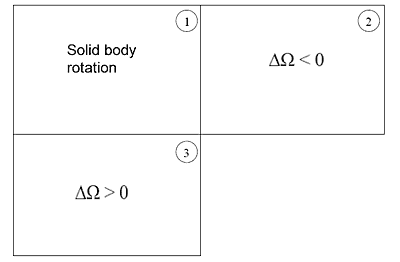Introduction | Tank – How to | Tank – Examples | Atmosphere – Examples | Theory| For Teachers | Wiki
A (very) simple theory of winds in the Ekman layer which we have found useful in introductory classes can be found in Section 7.4.2 of the notes here.
The matrix below is helpful in introducing three closely related tank experiments that can be carried out in sequence.
- solid body rotation in which the rotation rate is steady at a rate omega, a positive constant (anticlockwise rotation of tank).
- low pressure – slight decrease in rotation rate
- high pressure – slight increase in rotation rate
There is much to draw attention to, even in the solid body rotation experiment e.g. (i) parobolic free surface discussed in Section 6.6.4 here, evident to the eye even at modest rotation rates. This can lead on to discussions about the non-sphericity of the rotating earth discussed for example in Section 6.6.5 here. (ii) the concept of solid body rotation, which is not obvious to many students when they first come across it.
The matrix of the three cases can be obtained in PDF format here.
